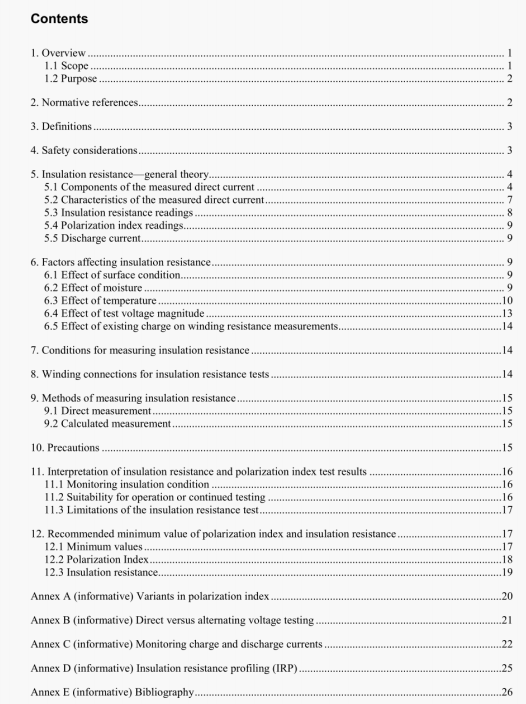IEEE 43:2013 pdf free download.IEEE Recommended Practice for Testing Insulation Resistance of Electric Machinery.
In-service machines are usually at a temperature above the dcw point. When tests are to be conducted on a machine that has been in service, the tests should be made before the machine winding temperature drops below the dew point.
Machines that are out-of-service (without space heaters) are frequently tested when the winding tcmperature is below the dcw point and may havc significantly lower than cxpectcd insulation resistance and polarization index readings due to moisture contamination (see Clause I I). It may be necessary to dry out these machines to obtain acceptable readings prior to returning these machines to service or performing high-voltage testing. For appropriate dry-out procedures, consult with the equipment manufacturer. The history of the machine, visual inspections, and other test results may help in assessing the potential risk of returning to service a machine with low insulation resistance andfor polarization indes readings due to moisture contamination. It is recommended that a machine with low P.!. and IR readings not be subjected to further high-voltage testing.
6.3 Effect of temperature
6.3.1 General theory
The insulation resistance value for a given system, at any given point in time, varies inversely, on an exponential basis, with the winding temperature. There is a contrast between the temperature dependence of resistivity in metals and non-metallic materials, especially in good insulators. In metals, where there are numerous free electrons, higher temperature introduces greater thermal agitation, which reduces the mean free path of electron movement with a consequent reduction in electron mobility and an increase in resistivity. Ilowever. in insulators, an increase in temperature supplies thermal energy, which frees additional charge carriers and reduces resistivity. This temperature variation affects all of the current components identified in 5.1 except for the geometric capacitive current. The insulation resistance value of a winding depends upon the winding temperature and the time elapsed since the application of the voltage. For example, when the machine has just been stopped, and the operating temperature is of the order of 90 °C 100 C, the temperature can drop significantly during 10 mm and this can affect the P.!. In order to avoid the effects of temperature in trend analysis, subseqLlent tests should be conducted when the winding is near the same temperature as the previous test. However, if the winding temperature cannot be controlled from one test time to another, it is recommended that all insulation test values be corrected to a common base temperature of 40 C using Equation 2). Though the corrected value is an approximation, this permits a more meaningful comparison of insulation resistance values obtained at dilkrcni temperatures.
IEEE 43:2013 pdf free download
